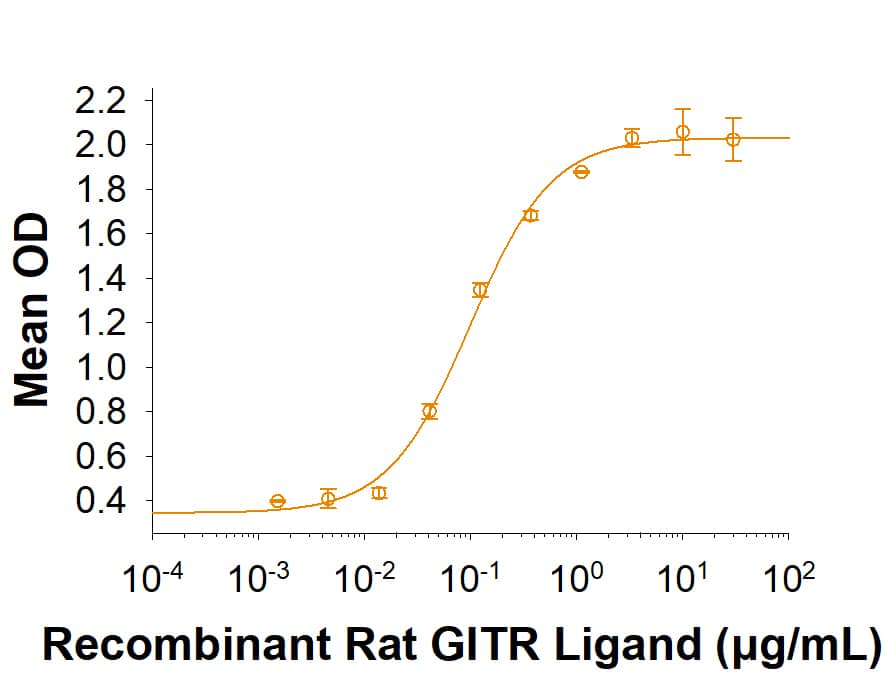GITR Ligand/TNFSF18 Products
GITR Ligand, also known as TNFSF18 and TL6, is a transmembrane glycoprotein that is expressed on antigen presenting cells, CD4-CD8- double negative thymic precursors, vascular endothelial cells, neurons, and in the eye. Its expression is transiently upregulated by proinflammatory stimulation. The binding of GITR Ligand to GITR on mouse CD25+ Treg cells permits the reactivation of T cells from Treg-induced suppression.
GITR Ligand binding to GITR additionally provides a costimulatory signal to activated CD4+ and CD8+ T cells and NK cells. This interaction also induces reverse signaling in GITR Ligand expressing dendritic cells to suppress cellular activation through the same pathway induced by the immunosuppressant dexamethasone. In the brain, GITR Ligand/GITR interactions enhance NGF-mediated neurite outgrowth from sympathetic neurons.
Products:
201 results for "GITR Ligand/TNFSF18" in Products
201 results for "GITR Ligand/TNFSF18" in Products
GITR Ligand/TNFSF18 Products
GITR Ligand, also known as TNFSF18 and TL6, is a transmembrane glycoprotein that is expressed on antigen presenting cells, CD4-CD8- double negative thymic precursors, vascular endothelial cells, neurons, and in the eye. Its expression is transiently upregulated by proinflammatory stimulation. The binding of GITR Ligand to GITR on mouse CD25+ Treg cells permits the reactivation of T cells from Treg-induced suppression.
GITR Ligand binding to GITR additionally provides a costimulatory signal to activated CD4+ and CD8+ T cells and NK cells. This interaction also induces reverse signaling in GITR Ligand expressing dendritic cells to suppress cellular activation through the same pathway induced by the immunosuppressant dexamethasone. In the brain, GITR Ligand/GITR interactions enhance NGF-mediated neurite outgrowth from sympathetic neurons.
Products:
| Assay Range: | 125 - 8,000 pg/mL |
| Applications: | ELISA |
| Reactivity: | Human |
| Details: | Mouse IgG1 Monoclonal Clone #109101 |
| Applications: | Flow |
| Source: | NS0 |
| Accession #: | AAO89011 |
| Applications: | BA |
| Applications: | Func, PAGE |
| Source: | NS0 |
| Accession #: | XP_008767927 |
| Applications: | BA |
| Source: | CHO |
| Accession #: | Q9UNG2.3 |
| Applications: | BA |
| Reactivity: | Human |
| Details: | Mouse IgG1 Monoclonal Clone #109101 |
| Applications: | Flow |
| Reactivity: | Human |
| Details: | Mouse IgG1 Monoclonal Clone #109114 |
| Applications: | Flow |
| Reactivity: | Human |
| Details: | Mouse IgG1 Monoclonal Clone #109101 |
| Applications: | Flow |
| Reactivity: | Human |
| Details: | Mouse IgG1 Monoclonal Clone #109114 |
| Applications: | Flow |
| Reactivity: | Human |
| Details: | Mouse IgG1 Monoclonal Clone #109101 |
| Applications: | Flow |
| Reactivity: | Human |
| Details: | Mouse IgG1 Monoclonal Clone #109101 |
| Applications: | Flow |
| Reactivity: | Human |
| Details: | Mouse IgG1 Monoclonal Clone #109114 |
| Applications: | Flow |
| Reactivity: | Human |
| Details: | Mouse IgG1 Monoclonal Clone #109101 |
| Applications: | Flow |
| Reactivity: | Human |
| Details: | Mouse IgG1 Monoclonal Clone #109114 |
| Applications: | Flow |
| Reactivity: | Human |
| Details: | Mouse IgG1 Monoclonal Clone #109114 |
| Applications: | Flow |
| Reactivity: | Human |
| Details: | Mouse IgG1 Monoclonal Clone #109114 |
| Applications: | Flow |
| Reactivity: | Human |
| Details: | Mouse IgG1 Monoclonal Clone #109114 |
| Applications: | Flow |
| Reactivity: | Human, Mouse |
| Details: | Rabbit IgG Polyclonal |
| Applications: | WB, ELISA, ICC/IF |
| Reactivity: | Human |
| Details: | Rabbit IgG Polyclonal |
| Applications: | IHC, WB, ELISA |
| Reactivity: | Human |
| Details: | Mouse IgG1 Monoclonal Clone #MM0312-4Q25 |
| Applications: | Flow, CyTOF-ready, B/N |
| Reactivity: | Human |
| Details: | Mouse IgG1 Monoclonal Clone #MM0312-4Q25 |
| Applications: | Flow, CyTOF-ready, B/N |
| Reactivity: | Human |
| Details: | Mouse IgG1 Monoclonal Clone #MM0312-4Q25 |
| Applications: | Flow, CyTOF-ready, B/N |
| Reactivity: | Human |
| Details: | Mouse IgG1 Monoclonal Clone #MM0312-4Q25 |
| Applications: | Flow, CyTOF-ready, B/N |




![Functional: Recombinant Mouse GITR Ligand/TNFSF18 Protein [NBP2-26579] Functional: Recombinant Mouse GITR Ligand/TNFSF18 Protein [NBP2-26579]](https://resources.bio-techne.com/images/products/Recombinant-Mouse-GITR-Ligand-TNFSF18-Protein-Functional-NBP2-26579-img0001.jpg)

![Western Blot: GITR Ligand/TNFSF18 AntibodyBSA Free [NBP1-77240] Western Blot: GITR Ligand/TNFSF18 AntibodyBSA Free [NBP1-77240]](https://resources.bio-techne.com/images/products/GITR-Ligand-TNFSF18-Antibody-Western-Blot-NBP1-77240-img0005.jpg)
![Immunohistochemistry-Paraffin: GITR Ligand/TNFSF18 Antibody [NBP2-80104] Immunohistochemistry-Paraffin: GITR Ligand/TNFSF18 Antibody [NBP2-80104]](https://resources.bio-techne.com/images/products/GITR-Ligand-TNFSF18-Antibody-Immunohistochemistry-Paraffin-NBP2-80104-img0001.jpg)
